Michael E. Byczek
Attorney
A new concept has emerged to use Artificial Intelligence (AI) to bring back the dead using their lifetime digital footprint with or without their consent.
This is called the Digital Afterlife.
The issue of right to privacy after death does not have a clear legal answer. There are two separate issues concerning data after death:
1. The data left behind after death, such as social media posts (the equivalent of digital remains).
2. Photos, video, text, and audio can be used for AI-generated interaction with the dead.
Digital Afterlife
Not only could the deceased be brought back to life through their visual likeness, but also through data used to train AI algorithms to actually carry on a conversation as if that person were a participant in a video call.
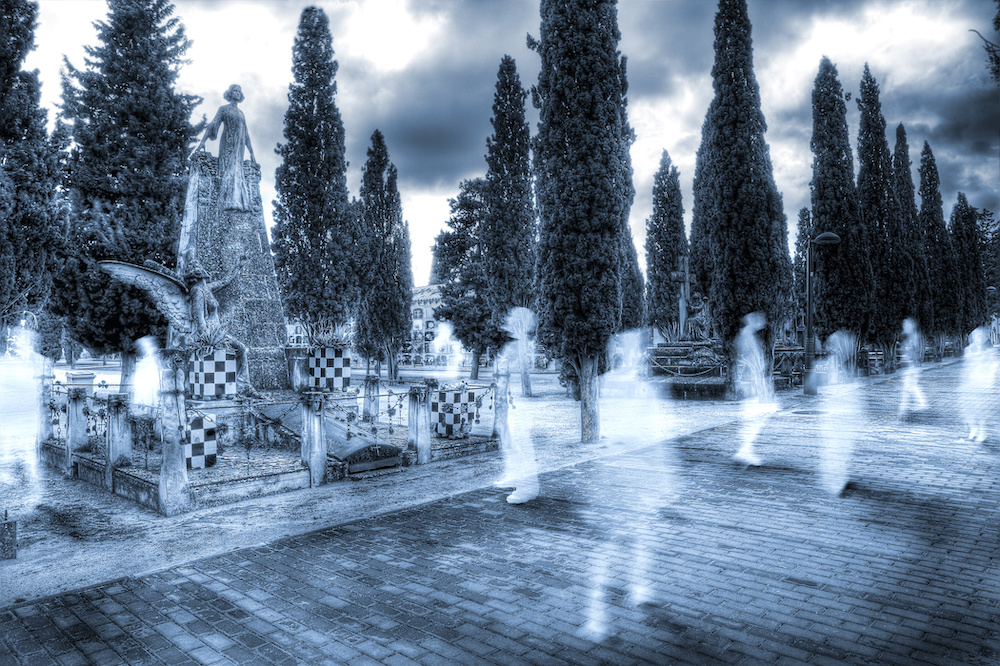 AI could use a person's entire lifetime of social media content, text messages, video blogs, family interactions, and other sources to learn how to think like that individual. This includes gestures, favorite quotes, emotions, and private details only close family would know.
AI could use a person's entire lifetime of social media content, text messages, video blogs, family interactions, and other sources to learn how to think like that individual. This includes gestures, favorite quotes, emotions, and private details only close family would know.
These AI-generated avatars could engage in real-time video/audio conversations, generate their own social media posts, give interviews, or communicate through written text, like a chatbot. Such digital content would appear seamless and realistic to a third-person observer who didn't know that person was actually dead.
The dead could virtually attend family celebrations, engage in discussions about world events, participate in political affairs, or provide legal opinions.
None of this may require consent because that individual is already dead. There is debate about whether the dead even have such rights. A question arises who can even bring a lawsuit and whether such litigation would be successful.
AI-generated afterlife profiles could be requested from family members who provide relevant data themselves or created by a third-party company on their own initiative. These companies (or private individuals) could gather information from publicly accessible data (i.e. social media, blogs, product reviews, websites, online marketplace transactions, employment, etc).
It could also be possible for third-party companies to obtain access to facial recognition logs to track every location you have ever visited (i.e. sporting events, public spaces, retail stores, hotels, etc). Credit card statements could be accessed along with traffic cameras that log license plates. IP logs may have tracked every website a deceased family member ever viewed.
Home security cameras and video doorbells could have stored archived footage of an individual long deceased. Online map companies, like Google or Bing Street View, have archived images that are decades old. It is possible to see glimpses of a deceased family member standing on the sidewalk in front of his/her home from many years ago.
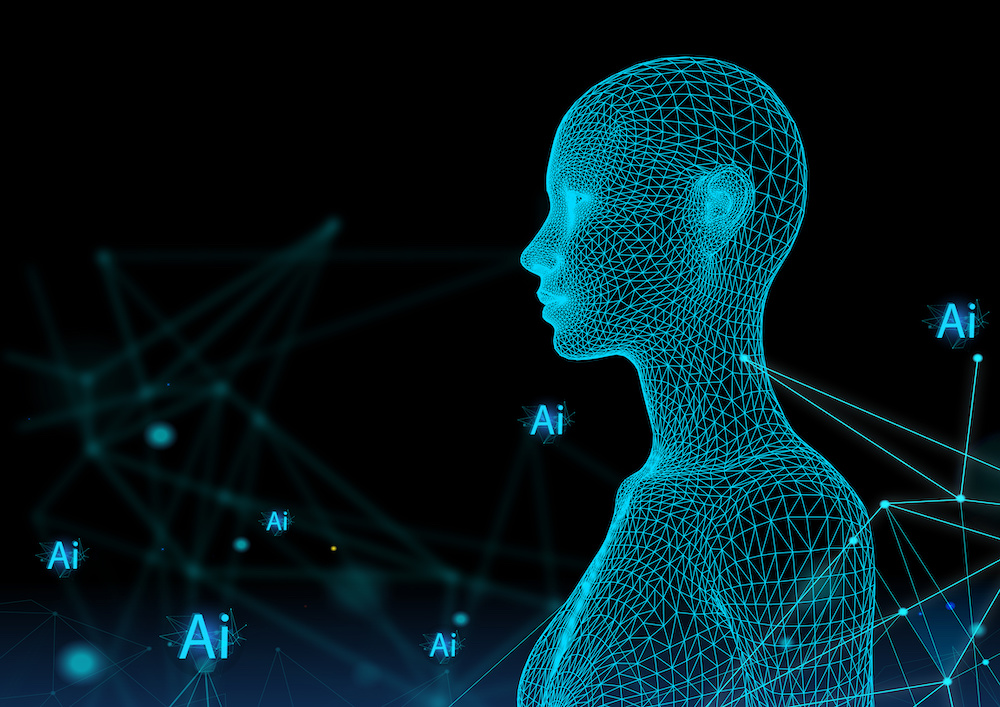 Smart watches and mobile health devices record data such as heart rate or steps taken. This data is not automatically erased just because the individual wearing the watch is now deceased.
Smart watches and mobile health devices record data such as heart rate or steps taken. This data is not automatically erased just because the individual wearing the watch is now deceased.
Standard U.S. copyright law transfers protected work to public domain 70 years after an author's death. This implies that companies could wait 70 years after a person's death to use their otherwise copyright-protected work for an AI-generated afterlife.
While a faithfully-represented private version of your digital self could provide comfort to family members, a public version could be derived from any amount of fake text, photos, videos, or audio.
You could be brought back to life in ways that you would never have consented:
- convey fabricated opinions or give advice
- spread lies about real people
- hurt your family, such as messages that target celebratory occasions
- discrimination or harassment
- criminal disposition
- profanity and vulgar language
- violent personality
- hate speech or make threats
- religious comments
- fake document creation
- AI-generated photo/video albums
- question paternity of your own children or claim fake paternity of others
- refer to fake physical relationships with real people
- confess to crimes that never happened
- expose your family to financial or legal liability
- reveal private information, such as bank account numbers or passwords
- tell truthful secrets about your family, such as compromising facts
- convey fake family memories
- interfere with business activities
Different companies could create competing versions of the same person resulting in an unlimited number of ways that the digital afterlife could turn into digital chaos. It is even possible for multiple family members to generate their own versions using different data (real or fake) that contradict each other.
The biggest risk is when AI is used to bring the dead back to life in a malicious manner, similar to how deepfake is used today.
 Software developers can use their own subjective viewpoints to build AI models and algorithms. Malicious parties could deliberately feed the AI platform fake data. As technology evolves over time, the same data could be interpreted differently with each new version of underlying algorithms. Legacy data or obsolete formats could cause unintended consequences with how AI platforms of the future analyze information.
Software developers can use their own subjective viewpoints to build AI models and algorithms. Malicious parties could deliberately feed the AI platform fake data. As technology evolves over time, the same data could be interpreted differently with each new version of underlying algorithms. Legacy data or obsolete formats could cause unintended consequences with how AI platforms of the future analyze information.
Your digital afterlife avatar could become a completely fictional character. This stolen identity could be controlled by unregulated tech companies or private individuals with a malicious motive.
It may sound innovative to think of your digital afterlife avatar interacting with future generations and your life preserved forever in cyberspace. However, this requires trust that whoever creates this AI-generated afterlife of yourself does so in good faith with your sincerest dignity in mind.
What happens when the underlying data used for your AI-generated afterlife is hacked, corrupted, or faked? What if your digital afterlife becomes a purely imaginative character that catastrophically deviates from the real you with devastating consequences for your family?
Digital Estate Plan
One solution to convey your instructions, consent or lack thereof, about a digital afterlife is through a digital estate plan.
A traditional Will provides written instructions about who should inherit your property. The alternative (dying without a Will) is for relatives or friends trying to convince a probate judge how they want your assets distributed, with an obvious emphasis on their own self-perceived benefit.
A digital estate plan defines your virtual life after death.
Traditional estate plans consist of multiple legal documents that pertain to what happens when an individual is dead. These include:
- Will
- Trust
- Pet Guardianship
- Power of Attorney
- Living Will for Health Care Decisions
- HIPAA Authorization
A digital estate plan is entirely dedicated to instructions about your digital footprint.
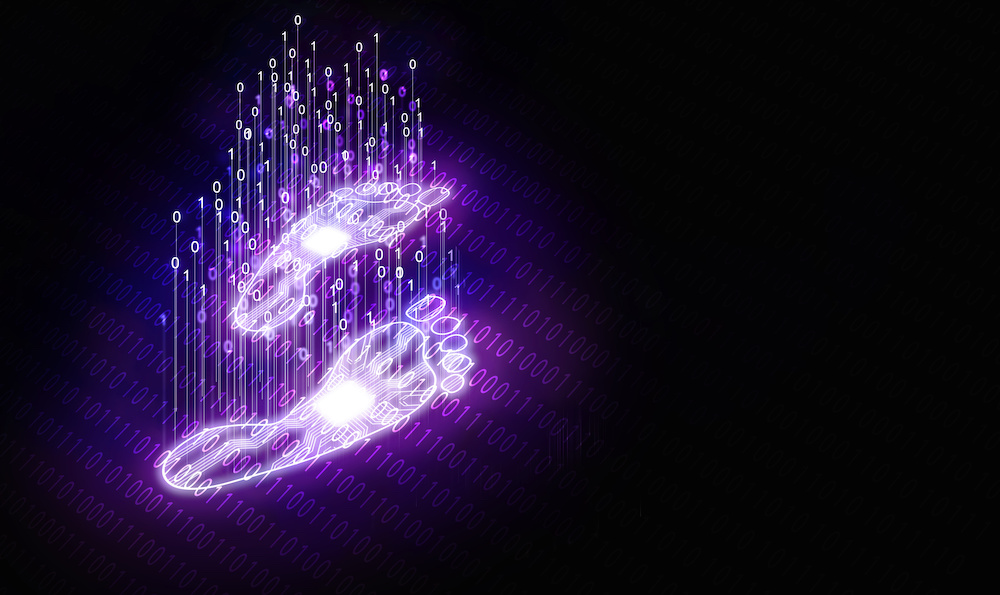 For example, consider the music or movies you own through a cloud-based download service provider (such as songs downloaded from Apple iTunes). The music itself are assets distributed through a Will. Cryptocurrency or NFTs (non-fungible tokens) in a crypto-wallet are also distributed in accordance with a Will. However, the empty iTunes account and crypto-wallet would fall under the digital estate plan. Do you want the account to stay open indefinitely, transferred to someone else, or closed?
For example, consider the music or movies you own through a cloud-based download service provider (such as songs downloaded from Apple iTunes). The music itself are assets distributed through a Will. Cryptocurrency or NFTs (non-fungible tokens) in a crypto-wallet are also distributed in accordance with a Will. However, the empty iTunes account and crypto-wallet would fall under the digital estate plan. Do you want the account to stay open indefinitely, transferred to someone else, or closed?
A cloud-based photo sharing album may contain the only copies of important multimedia content. The photos and videos themselves would pass through a Will. However, access to the online album does not automatically terminate when copies of the content are given to family members. A digital estate plan could provide that the album remain open, made public, or be completely deleted.
Now consider social media accounts. Once you die, your family may not have legal authority to close your account or delete content. It's possible for these accounts to remain publicly accessible forever (or until the company goes out of business or closes inactive accounts). These accounts and what happens after death are typically not covered by a standard Will or probate court procedure.
A digital estate plan is a legal document that reads like a digital inventory of your life with corresponding instructions.
It is recommended to keep this document separate from your traditional Will because it contains very specific and private information, like passwords and direct URL access to content that may have been anonymous during life. It is also intended that you update the digital estate plan frequently and regularly.
The digital estate plan is incorporated into the standard Will, such as referencing its existence and highlighting the main points without providing every login password. You wouldn't put the login credentials for your grocery store rewards card intermingled with what happens to your real estate or vehicle.
A traditional Will requires that you appoint an executor of your estate. This person is an administrator who carries out your final wishes, oversees the probate process (i.e. paperwork that is required when somebody is dead), and property distribution.
A digital estate plan requires a digital executor (also called a data executor). This individual administers your instructions, such as deleting photos from social media. It's possible to name the same person, but this is not a requirement.
Legal issues intended to be resolved with a digital estate plan include:
- How do you define your own digital afterlife?
- Do others have the right to make such decisions?
- Who has such rights?
- Is your express consent required for anybody to create your own AI-generated afterlife?
- If you decide to completely vanish upon death, is this decision enforceable?
- If created without consent, how can your family delete or remove such an afterlife?
- What if your digital afterlife is created long after your immediate family is dead?
- What if you don't have family alive anymore?
- What if you don't want a digital afterlife, but nobody knows?
- What happens if these AI-generated afterlife profiles go too far?
- How or who can force the complete removal of your digital afterlife?
- Can you restrict certain aspects of a digital afterlife, such as automated social media posts?
- Can you make such a digital afterlife only privately available to designated family?
Generalized instructions, such as the desire to completely vanish upon death, should be incorporated into the Will as formal final wishes. The Will should then refer to the existence of a digital estate plan for the particular details that the data executor shall administer (i.e. login credentials).
The digital estate plan should take inventory of all and everything where data exists:
- Personal information (i.e. saved passwords, locally stored photos, memos, etc)
- Computers, smart phones, tablets, and external hard drives
- Text messages, voice messages, and text from chatroom archives
- Social media accounts
- Contact lists
- Cloud-based storage accounts and photo/video sharing sites
- Email accounts
- Financial accounts (i.e. bank and credit card) and crypto-wallets (i.e. NFTs)
- Insurance policies
- Online dating
- Online gaming
- Online marketplaces (i.e. Amazon and eBay)
- Product review sites (i.e. Yelp or Google)
- Online businesses (i.e merchant accounts on Amazon, eBay, or Etsy).
- Websites or blogs
- Businesses or investments
- Employment data
- Intellectual property (patents, trademarks, or copyrights)
- Domain names
- Subscription or online service providers (i.e. Netflix or newspapers).
- Online utility accounts
- Loyalty reward programs (i.e. grocery or airlines)
- General online activity where websites require login credentials
- Archived AI chatbot history (i.e. ChatGPT account)
- Mobile apps or digital books, both created or downloaded by yourself
- Apps, music, books, or movies purchased through online digital libraries
- Online access to medical or health records (i.e. smart watch heart rate)
You should outline specific instructions (or collective) for these digital assets/accounts along with necessary login information. This includes secret questions, phone numbers used to open the account, and other details needed by your data executor to access these accounts. This includes what email accounts were used and access to a phone that may require a one-time passcode to complete login.
If an email account is closed or phone number deactivated too quickly, your data executor could be locked out of an account. This would require probate procedure and direct contact with each company to gain access, which may not involve direct control.
 Another use of a digital estate plan is to create your own version of a digital afterlife in advance. You could prepare photos and videos along with a biographical sketch that you compiled yourself. This could be part of the digital estate plan, such as an offline website or social media content ready to be posted by the data executor. You could also prepare a variety of video messages for specific topics, subjects, or Q/A. These videos could be available publicly or privately to your family.
Another use of a digital estate plan is to create your own version of a digital afterlife in advance. You could prepare photos and videos along with a biographical sketch that you compiled yourself. This could be part of the digital estate plan, such as an offline website or social media content ready to be posted by the data executor. You could also prepare a variety of video messages for specific topics, subjects, or Q/A. These videos could be available publicly or privately to your family.
For instance, you could save these files on a USB flash drive and keep it with your estate plan.
It is impossible to stop all references to yourself posted on the Internet during your lifetime or after death. It's equally impossible to stop all forms of an AI-generated afterlife being created for whatever reason or motive. There is nothing that you or your family can do to stop third-parties acquiring data about yourself (real or fake). The question is how do you protect yourself after death?
One solution is a digital estate plan with specific language that grants your executor enough authority to take necessary steps now and in the future.
An analogy is identity theft during your lifetime. You cannot stop somebody using your stolen credit card number, posting to a fake social media account, or buying a car in your name. What matters is your legal ability to take immediate action.
Your best strategy for identity theft is acting quickly once detected and taking proper legal steps to clear your name, whether this is a fake social media account or fraudulent transactions. A digital estate plan grants a data executor authority to cleanse your digital footprint in advance, and in combination with a traditional Will, provide some form of authority for your family to enforce your digital afterlife decisions.
The Revised Uniform Fiduciary Access to Digital Assets Act (RUFADAA)
RUFADAA is a legal framework for who should have access to digital assets of a deceased or incapacitated individual. It provides procedures for an executor to request and the custodians of the data to provide access to accounts.
This is different from an estate plan that expressly grants such authority and includes all login credentials necessary for a data executor to carry out these instructions. Without these login credentials, it's possible that the data executor may be required to provide copies of the death certificate, Will, and court order to every company before getting access to the data. Even then, the companies may not allow the data executor direct access to the account.
Example: An executor wants to download all private photos on a deceased family member's social media account. However, he/she had a basic Will or none at all. His/her login credentials cannot be found. The executor must petition the court for permission to request this access from the social media company. The court may require proof that such action is necessary and may not grant such a request. If granted, the executor must make a written request to the social media company and provide copies of relevant legal documents. It's possible the court will only grant access to the photos, but not order account deletion. The social media company will provide copies of the photos after receiving the RUFADAA request, but may not do anything further. It's also possible that since the deceased family member labeled these photos private, the social media company, and/or the court, may not provide access. If the deceased family member had a digital estate plan with clear instructions and complete login credentials, the data executor could just go straight to the account and carry out these steps.
The RUFADAA specifically refers to criminal laws that pertain to computer fraud and unauthorized computer access.
The Illinois RUFADAA is enacted by legislation (755 ILCS 70).
Digital Afterlife Patent Example
On 12/1/2020, Microsoft received a U.S. patent titled "Creating a Conversation Chat Bot of a Specific Person" (US 10,853,717). This patent highlights the reality that tech companies are actually working on ways to bring the dead back to life as an AI-generated 3D profile as part of a digital afterlife.
Abstract:
Examples of the present disclosure describe systems and methods of creating a conversational chat bot of a specific person. In aspects, social data (e.g., images, voice data, social media posts, electronic messages, written letters, etc.) about the specific person may be accessed. The social data may be used to create or modify a special index in the theme of the specific person's personality. The special index may be used to train a chat bot to converse in the personality of the specific person. During such conversations, one or more conversational data stores and/or APIs may be used to reply to user dialogue and/or questions for which the social data does not provide data. In some aspects, a 2D or 3D model of a specific person may be generated using images, depth information, and/or video data associated with the specific person.
Highlights from the patent description:
A machine learning model may analyze a set of social data to identify and categorize content, content attributes, content authors/contributors, data sources, etc. Such an analysis may include categorizing the social data by type (e.g., textual data, audio data, image data, etc.), determining the source/author(s) of the social data (e.g., a specific person/entity, one or more other persons similar to a specific person/entity, subject matter experts, random users, etc.), determining the degree of similarity between a specific person/entity and alternate sources/authors, identifying question and answer pairs, identifying dialogue expressions, etc. The analysis of social data may also include evaluating photo data in (or associated with the social data. Such an evaluation may include using, for example, deep learning to detect tags in (and/or attributes of) the photo data, process (e.g., identify, annotate, summarize, etc.) the events in the photo data, and/or correlate the detected tags with the processed photo data. The analysis of social data may further include evaluating voice data in (or associated with) the social data. Such an evaluation may include using speech recognition and/or speech syntheses techniques to generate a voice font corresponding to a specific person/entity. Further still, the analysis of social data may include generating and/or evaluating 2D/3D data in (or associated with) the social data. Such an evaluation may include using 2D/3D modeling techniques (and associated data) to generate a 2D or 3D model corresponding to a specific person/entity.
The specific person may correspond to a past or present entity, such as a friend, relative, acquaintance, celebrity fictional character, historical figure, random entity, or oneself.
Social data may refer to images, image data, voice data, emails, text messages, dialogue data/commands, social media posts, written letters, user profile information, behavioral data, transactional data, geolocation data, and other forms of data about a specific person.
The patent application uses the example of creating an AI-generated version of Abraham Lincoln using his handwritten letters to learn about him.
1st claim of the patent:
A system comprising: at least one processor; and memory coupled to the at least one processor, the memory comprising computer executable instructions that, when executed by the at least one processor, performs a method for creating and interacting with a conversational chat bot of a specific entity, the method comprising: receiving a request associated with a specific entity; accessing social data associated with the specific entity, the social data comprising at least one of: images of the specific entity, voice data for the specific entity, conversational data associated with the specific entity, and publicly available information about the specific entity; using the social data to create a personality index, wherein the personality index comprises personality information for the specific entity; using the personality index to train ac hat bot to interact conversationally using the personality information of the specific entity; receiving, by the chat bot, dialogue; generating, by the chat bot, a response to the dialogue using a hierarchical data traversal process to collect response data from one or more data sources accessible to the personality index, wherein collecting the response data comprises: determining, by the chat bot, the personality index does not comprise data for addressing one or more parts of the dialogue; composing, by the chat bot, one or more questions to address the data not comprised in the personality index; and providing. to a user interacting with the chat bot, the one or more questions.
5th claim of the patent:
The system of claim 1, the method further comprising: processing the social data using at least one of machine learning techniques and one or more rule sets; and applying the processed social data to the personality index to generate a personalized personality index.
7th claim of the patent:
The system of claim 1, wherein training the chat bot comprises applying to the chat bot at least one of a voice font of the specific entity, a 2D image of the specific entity, and a 3D image of the specific entity.
Representative drawings from the patent:
FIG. 3 illustrates an example method of creating a conversational chat bot of a specific person
FIG. 6 is a simplified block diagram of a distributed computing system in which aspects of the present disclosure may be practiced.
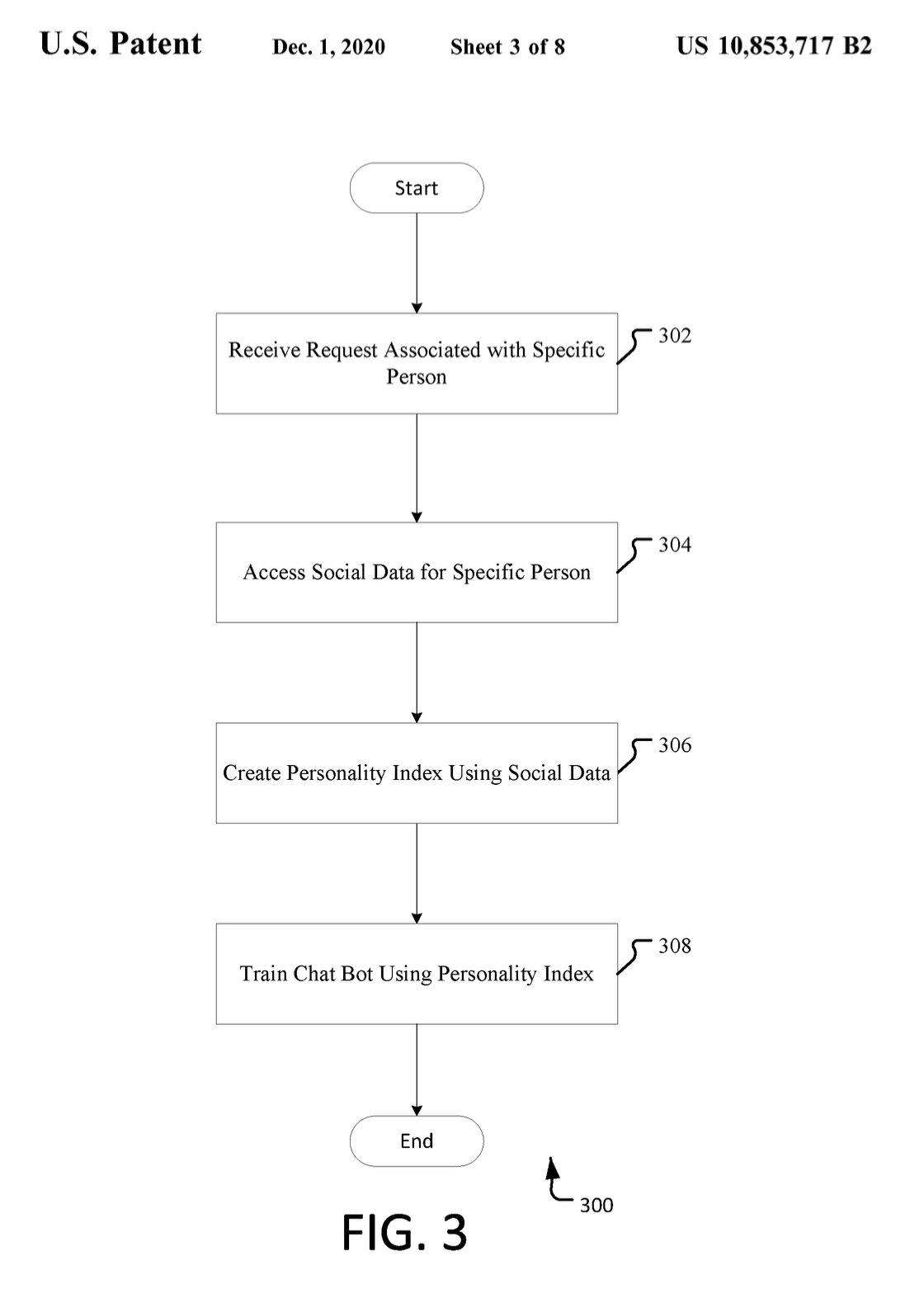
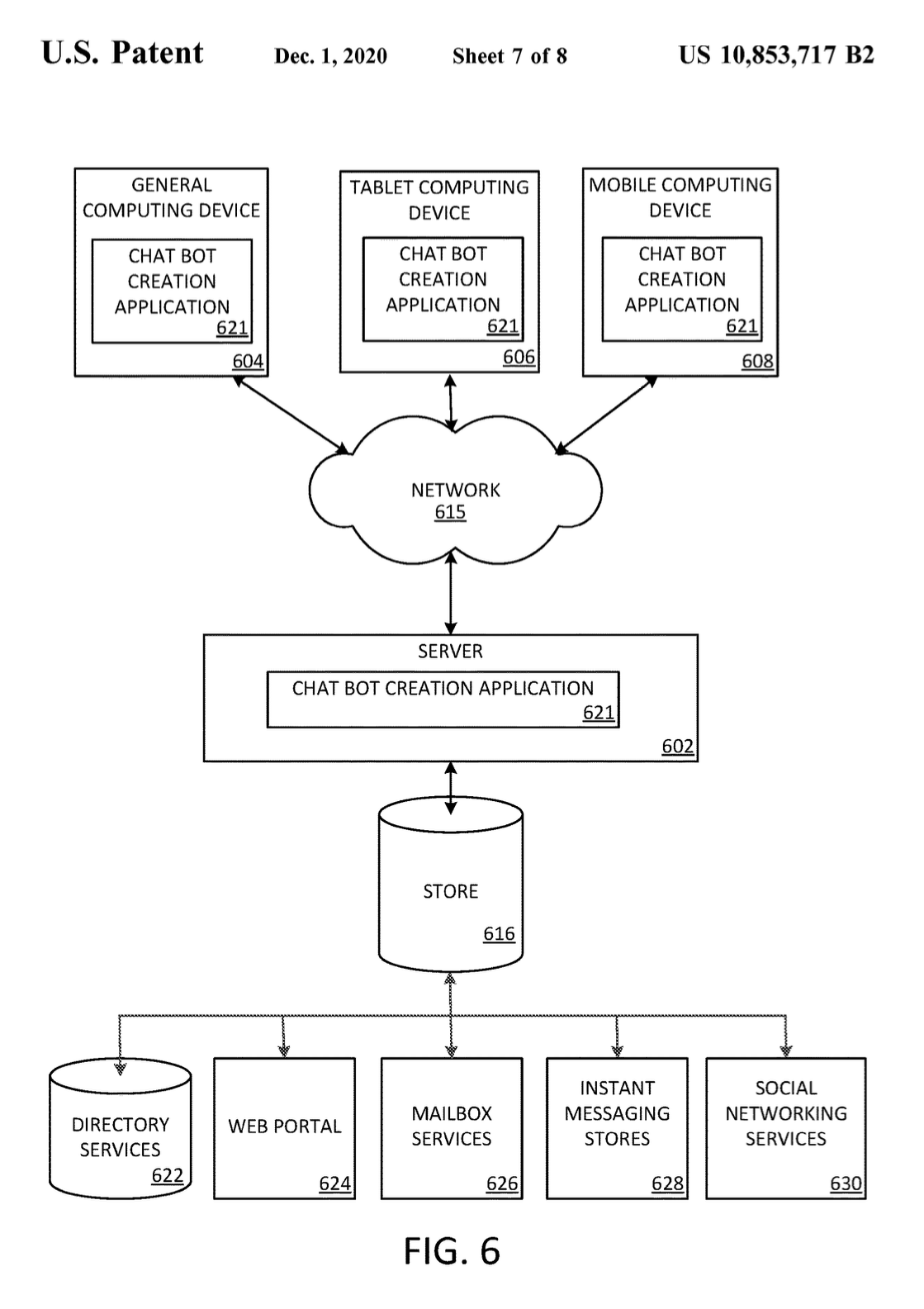
Conclusion
The overall goal is to avoid dying without a Will, regardless of traditional or digital issues.
Without a traditional estate plan, your property will be distributed according to probate laws, overseen by a probate judge, and administered by somebody and/or in such ways that you would never have wanted.
Without a digital estate plan, your digital afterlife is just as unpredictable. This is true for both your digital remains (i.e. social media photos) and an AI-generated afterlife avatar (both dignified and malicious).
The best strategy is to provide enough clearly written formal instructions about your actual decisions regarding a digital afterlife.
Useful Links
The Creepy New Digital After Industry. IEEE Spectrum Magazine (Institute for Electrical and Electronics Engineers). 10 Oct 2023. https://spectrum.ieee.org/digital-afterlife [Accessed 11/6/2023]
Four things you might not know about your digital afterlife. BBC Science Focus. https://www.sciencefocus.com/future-technology/four-things-you-might-not-know-about-your-digital-afterlife [Accessed 11/6/2023]
Stock Images
Some of the images used on this website are from Adobe Stock Images (#594117445, #591579553, #442285771, #307774024, #285311422).
Main Page Estate Plans